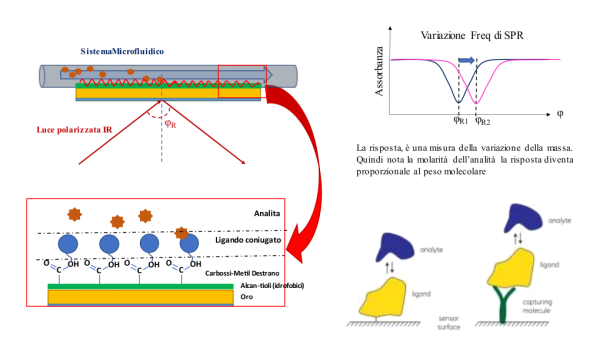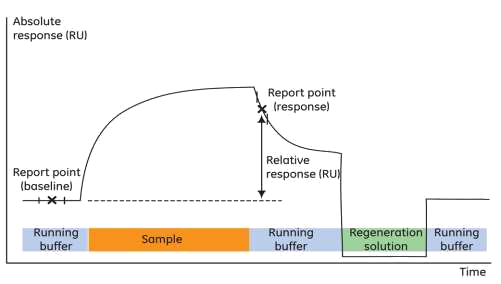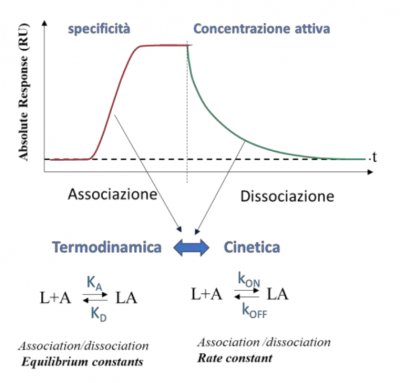EPR Area
Surface Plasmon Resonance (SPR - Biacore)
Methodology
The SPR is substantially a very precise molecular scale, able to report the binding of a single amino acid (100 Da), with a sensibility of few pg/mm² in a pM range of the bulk.
If polarized light is focalized on a thin gold layer starting from a condition of total reflection and then the angle is let to be changed, measuring the intensity of the reflected beam it appends that at a specific angle of incidence occurs a peak of absorption, this peak it is due to the resonance of the surface plasmon of the gold layer. This plasmon is the quantic wave associated with the electrons present in the conduction band of the metal, thus it can be put in resonance by the energy associated with incident photons.
Since the plasmon arises from the conduction band it is a superficial wave running along the metal surfaces, thus its frequency is very sensitive to what's appends on the metal surface and also a small bound with a molecule on metal can induce a large variation of the SPR angle or measuring the beam intensity at a fixed angle the signal has a variation.
The SPR - BIACORE System
Biacore X-100, from Cytiva, take into account this principle.
The main instrumentation elements are:
- The chip. Here we describe the “General Purpose“ CM (carboxymethyl dextran) chip, but there are several kinds of chips for specific applications. A thin 50nm gold layer has been stratified onto a glass holder. The gold layer is then covered by a hydrophobic Alcan thiols layer and finally by carboxymethyl dextran. This molecule is generally suited to anchor proteins, ssDNA, mAbs, chelating complexes as well streptavidin. As well it is possible to immobilize lipid ligands monolayers (HPA-chip) or bilayers (L1-chip).
- The microfluidic system. This system is made by two chamber laser carved on the chip and a set of several microfluidics valves, tubes and a peristaltic pump. This system allows superfusing the chamber independently of in cascade according to the specific requirement. Typically on a first step, the ligand is immobilized on one of the two-cell letting the other as the reference cell, since the buffer interactions with the chip surface have to be taken into account.
Once the immobilization has been successfully carried out, the analyte is dissolved in an appropriate buffer and perfused on both the cells but of course,
the bound will be obtained only where the ligand is stratified.
The bonding of a single analyte molecule produces a deep modification in the SPR and thus in the intensity of the signal between the cell and its reference. This signal is presented as a Sensorgram plotting the response units (RU) against the time.
The experimental protocol is obtained thanks to a well suited graphical interface on the instrument benchtop allowing to program all the steps that the instrument has to perform. In this step to step guided procedure, some Report Points has to be defined at specified times during the experiment, where it is possible to states the volume that has to be injected into the microfluidic system. Once the protocol has been carried out and the sample has been loaded onto the tray, the experiment can start.
After sample injections, molecules of the sample, buffer ions and impurities start interacting with the sensor surface until there is full saturation of the sites, parts of these interactions are not specific, thus just after there is washing out of the fluidic system by running buffer, the detachment of unspecific interactions occurs leaving the real interaction against the baseline. Moreover, according to the experiment, it is also possible to choose two alternative modalities: consecutive injections vs repetitive injections cyles. At the end of each cycle, the sensor chip has to be regenerated detaching all the analyte from the surface leaving unmodified ligand on the surfaces this allows reusing more and more time the same sensor chip (employing a specific high ion force solution).
The Sensogram
From the Sensogram it is possible to obtain kinetics information such as association and dissociation by fitting experimental data with specific models as well as thermodynamic information (enthalpy, entropy and Free Gibbs energy) since the device can control the temperature from 4 to 45 °C.
Amongst the applications are presented some explanatory approaches to catch these parameters.



